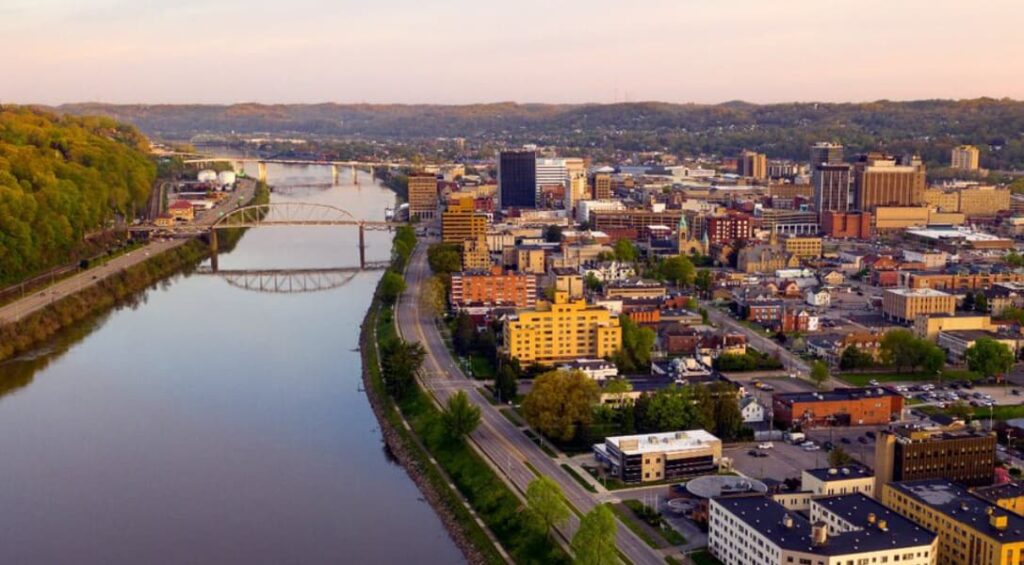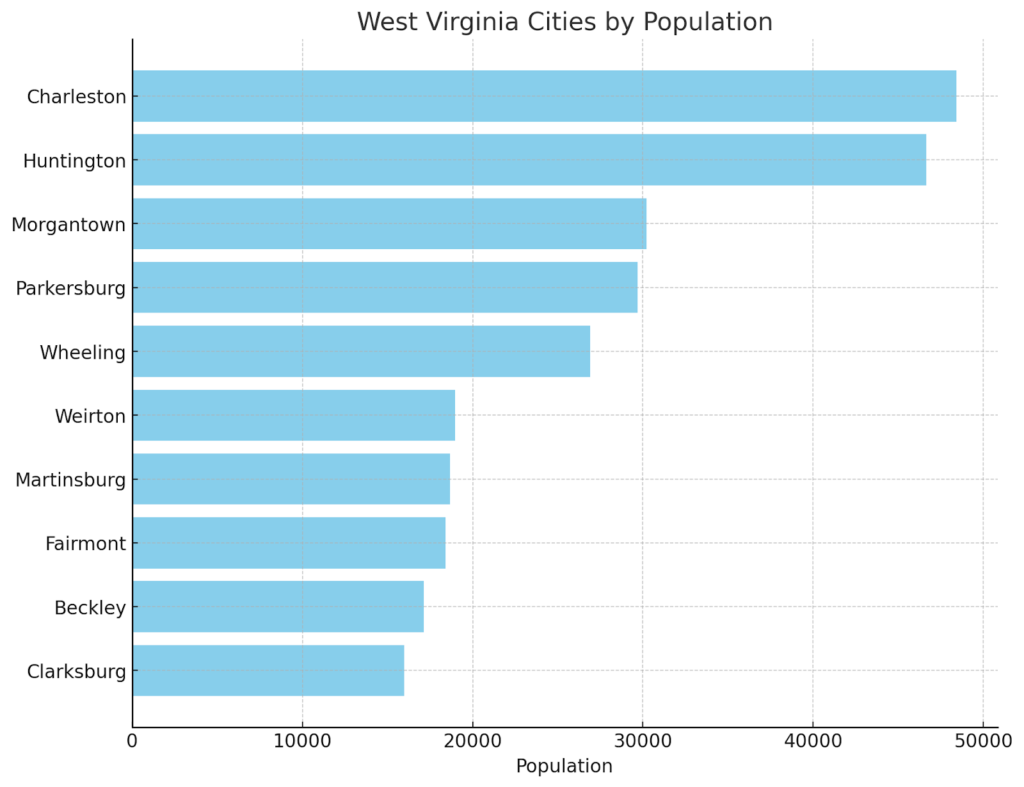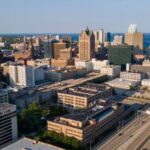
West Virginia, known for its rich history in coal mining and stunning Appalachian landscapes, offers a unique blend of cultural and natural attractions. As the only state entirely within the Appalachian Mountain range, it boasts scenic beauty and a rich heritage that attracts visitors and residents alike. The state’s cities, though smaller compared to those in other states, are vibrant communities with their own unique characters and histories. This article explores the top 10 most populous cities in West Virginia, highlighting what makes each city special.
What are the Top West Virginia Cities by Population?

1. Charleston (Population: 48,415)
As the capital and largest city of West Virginia, Charleston sits at the confluence of the Elk and Kanawha Rivers, marking it as a significant point of interest. It serves not only as the political heart of the state but also as a central hub for cultural and economic activities. The city is distinguished by its historic Capitol Building, which stands as a testament to its rich political heritage. The scenic Kanawha Boulevard runs alongside the river, offering breathtaking views and a serene environment for both locals and tourists. Charleston’s annual cultural extravaganza, FestivALL, transforms the city into a vibrant canvas of artistic expressions, attracting artists and attendees from across the nation. Beyond its urban charm, Charleston is surrounded by natural beauty, with the West Virginia State Museum showcasing the state’s history and the Kanawha State Forest providing outdoor enthusiasts with a plethora of recreational activities. This unique blend of urban sophistication and natural splendor makes Charleston a compelling destination for those seeking a rich cultural experience amidst the beauty of West Virginia’s landscapes.
2. Huntington (Population: 46,637)
Huntington, located on the Ohio River, is known for its vibrant arts scene, historical significance, and as the home of Marshall University. The city’s downtown area is a hub of activity, with the Pullman Square shopping center, the Keith-Albee Theatre, and numerous parks and recreational areas. Huntington also prides itself on its efforts towards revitalization and community development, making it a city focused on the future while honoring its rich past.
The arts scene in Huntington is diverse, with galleries showcasing local talent alongside performances at the Keith-Albee Theatre, a historic landmark dating back to the 1920s. Marshall University adds to the city’s cultural fabric with its academic and athletic programs, drawing students and visitors alike. Additionally, the city’s location along the Ohio River offers opportunities for outdoor recreation, including boating, fishing, and hiking in nearby state parks.
3. Morgantown (Population: 30,220)
Home to West Virginia University, Morgantown is a lively college town with a youthful vibe and dynamic cultural scene. The city offers a variety of outdoor activities, thanks to its location near the Monongahela River and the surrounding hills. Morgantown’s High Street is famous for its nightlife, restaurants, and shops, catering to both the student population and residents. The city also hosts numerous festivals and events, adding to its vibrant community life.
With its strong academic presence, Morgantown benefits from a diverse population and a range of cultural offerings. The university’s arts programs contribute to the city’s creative atmosphere, with galleries and theaters showcasing local talent. Additionally, Morgantown’s proximity to nature allows for hiking, biking, and kayaking adventures in nearby Coopers Rock State Forest or along the rail-trails that wind through the region. Moreover, Morgantown’s commitment to sustainability and environmental initiatives has earned it recognition as one of the state’s greenest cities. The Morgantown Farmers Market and local co-ops promote sustainable living, while initiatives like bike-sharing programs encourage eco-friendly transportation options. Overall, Morgantown’s blend of academic excellence, outdoor recreation, and vibrant culture make it a unique and inviting destination.
4. Parkersburg (Population: 29,685)
Situated along the Ohio River, Parkersburg is known for its historical sites and the beautiful Blennerhassett Island Historical State Park. The city has a rich history tied to the early oil and gas industry, and its heritage can be explored through various museums and historic districts. Parkersburg also offers outdoor recreation opportunities, including boating and fishing on the Ohio River, making it a city with a blend of history and natural beauty.
Parkersburg’s historic downtown district is a testament to its past, with well-preserved buildings housing shops, restaurants, and cultural attractions. Visitors can explore sites like the Oil and Gas Museum to learn about the region’s industrial legacy or take a leisurely stroll along the Riverwalk, enjoying scenic views of the Ohio River. Additionally, Blennerhassett Island Historical State Park provides a unique opportunity to step back in time and experience life in the early 19th century, with guided tours of the historic mansion and carriage rides around the island.
5. Wheeling (Population: 26,900)
Wheeling, once a pivotal city in the American frontier and industrial era, is renowned for its historic architecture, including the Victorian-era Wheeling Suspension Bridge. The city’s heritage is preserved in the Wheeling National Heritage Area, which includes the Centre Market and the Capitol Theatre. Wheeling also offers outdoor attractions, such as Oglebay Park and the Wheeling Heritage Trail, making it a city where history and outdoor activities meet.
In addition to its rich history, Wheeling boasts a thriving arts and cultural scene, with galleries, theaters, and live music venues showcasing local talent. The annual Wheeling Arts and Cultural Fest celebrates the city’s creative spirit, featuring performances, art exhibitions, and interactive workshops. Outdoor enthusiasts can explore the miles of hiking and biking trails at Oglebay Park or take a leisurely stroll along the Wheeling Heritage Trail, which offers panoramic views of the Ohio River and the city skyline. Whether exploring its historic sites or enjoying its natural beauty, Wheeling offers something for everyone to enjoy.
6. Weirton (Population: 18,971)
Weirton, uniquely positioned in the Northern Panhandle, stretches across the Ohio River into both Ohio and Pennsylvania. The city has a strong industrial heritage, primarily driven by its steel manufacturing history. Today, Weirton is transitioning, focusing on community development and recreational opportunities, including the Panhandle Recreation Trail, offering residents and visitors a glimpse into both its past and future.
Weirton’s revitalization efforts are evident in its downtown area, where historic buildings have been repurposed into shops, restaurants, and entertainment venues. The city’s close-knit community comes together for events like the Weirton Summerfest, featuring live music, food vendors, and family-friendly activities. Outdoor enthusiasts can explore the Panhandle Recreation Trail, which winds through scenic landscapes and offers opportunities for hiking, biking, and birdwatching. Additionally, the nearby Ohio River provides opportunities for boating, fishing, and other water-based activities. With its rich history and commitment to progress, Weirton is a city on the rise, embracing its heritage while embracing the future.
7. Martinsburg (Population: 18,678)
As the largest city in the Eastern Panhandle, Martinsburg offers a mix of history, culture, and modern living. The city’s downtown area is characterized by its historic buildings, local shops, and restaurants. Martinsburg’s proximity to the Baltimore-Washington metropolitan area provides the benefits of a smaller city lifestyle while being close to major urban centers. The city also serves as a gateway to the Shenandoah Valley and the recreational activities available in the nearby mountains.
8. Fairmont (Population: 18,402)
Known as the “Friendly City,” Fairmont is located along the Monongahela River and is home to Fairmont State University. The city has a rich history in the coal mining industry and is famous for its “Pepperoni Roll,” a local culinary delight. Fairmont’s parks and rivers provide ample opportunities for outdoor activities, and its community-oriented approach makes it a welcoming city for all who visit or reside there.
9. Beckley (Population: 17,132)
Nestled in the heart of coal country, Beckley offers a unique insight into the coal mining history of West Virginia. The Beckley Exhibition Coal Mine allows visitors to experience a coal mine firsthand. The city is also a gateway to outdoor adventures, with its proximity to the New River Gorge National Park and Preserve, offering world-class whitewater rafting, hiking, and rock climbing. Beckley blends its industrial heritage with natural beauty and recreation.
10. Clarksburg (Population: 15,977)
Clarksburg, known as the “Jewel of the Hills,” is located in the North Central region of West Virginia. The city is rich in Italian-American culture, celebrated through annual festivals and events. Clarksburg’s downtown area is undergoing revitalization, aiming to attract new businesses and cultural activities. The city also offers parks and recreational areas, making it a community-focused city with a vision for the future.
These cities, each with their own unique character and history, together embody the spirit of West Virginia. From the bustling streets of Charleston to the historical depths of Beckley, West Virginia’s cities offer a diverse range of experiences for everyone. Whether you’re drawn to the state’s rich history, its natural beauty, or its vibrant communities, West Virginia has something to offer.
Last modified: February 29, 2024

